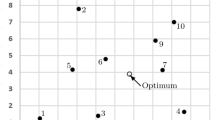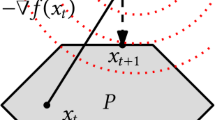Abstract
In 1937, the 16-years-old Hungarian mathematician Endre Weiszfeld, in a seminal paper, devised a method for solving the Fermat–Weber location problem—a problem whose origins can be traced back to the seventeenth century. Weiszfeld’s method stirred up an enormous amount of research in the optimization and location communities, and is also being discussed and used till these days. In this paper, we review both the past and the ongoing research on Weiszfed’s method. The existing results are presented in a self-contained and concise manner—some are derived by new and simplified techniques. We also establish two new results using modern tools of optimization. First, we establish a non-asymptotic sublinear rate of convergence of Weiszfeld’s method, and second, using an exact smoothing technique, we present a modification of the method with a proven better rate of convergence.



Similar content being viewed by others
References
Eiselt, H.A., Marianov, V.: Pioneering developments in location analysis. In: Eiselt, H.A., Marianov, V. (eds.) Foundations of Location Analysis, International Series in Operations Research & Management Science, vol. 155, pp. 3–22. Springer, Berlin (2011)
Drezner, Z., Klamroth, K., Schöbel, A., Wesolowsky, G.O.: The Weber problem. In: Drezner, Z., Hamacher, H.W. (eds.) Facility Location: Applications and Theory, International Series in Operations Research & Management Science, pp. 1–36. Springer, Berlin (2002)
Boltyanski, Y., Martini, H., Soltan, V.: Geometric Methods and Optimization Problems, Combinatorial Optimization, vol. 4. Kluwer Academic Publishers, Dordrecht (1999)
Jahn, T., Kupitz, Y.S., Martini, H., Richter, C.: The Fermat-Torricelli problem, Part II: Geometric aspects, open and related problems, and new generalizations. J. Optim. Theory Appl. (to appear)
Weiszfeld, E.V.: Sur le point pour lequel la somme des distances de n points donnes est minimum. Tohoku Math. J. 43, 355–386 (1937)
Vazsonyi, A.: Pure mathematics and the Weiszfeld algorithm. Decis. Line 33, 12–13 (2002)
Sturm, R.: Ueber den Punkt kleinster Entfernungssumme von gegebenen Punkten. J. Rein. Angew. Math. 97, 49–61 (1884)
Ostresh, L.M.: On the convergence of a class of iterative methods for solving the Weber location problem. Oper. Res. 26, 597–609 (1978)
Bazaraa, M.S., Sherali, H.D., Shetty, C.M.: Nonlinear Programming: Theory and Algorithms, 3rd edn. Wiley, London (2006)
Kupitz, Y.S., Martini, H., Spirova, M.: The Fermat-Torricelli problem, part I: a discrete gradient-method approach. J. Optim. Theory Appl. 158(2), 305–327 (2013)
Weiszfeld, E.: On the point for which the sum of the distances to \(n\) given points is minimum. Ann. Oper. Res. 167, 7–41 (2009). Translated from the French original [Tohoku Math. J. 43 (1937), 355–386] and annotated by Frank Plastria
Kuhn, H.W., Kuenne, R.E.: An efficient algorithm for the numerical solution of the generalized Weber problem in spatial economics. J. Reg. Sci. 4, 21–34 (1962)
Beck, A., Teboulle, M.: Gradient-based algorithms with applications to signal recovery problems. In: Palomar, D., Eldar, Y. (eds.) Convex Optimization in Signal Processing and Communications, pp. 139–162. Cambridge University Press, New York (2009)
Kuhn, H.W.: A note on Fermat’s problem. Math. Program. 4, 98–107 (1973)
Miehle, W.: Link-length minimization in networks. Oper. Res. 6, 232–243 (1958)
Cooper, L.: Location-allocation problems. Oper. Res. 11, 331–343 (1963)
Bertsekas, D.P.: Nonlinear Programming, 2nd edn. Athena Scientific, Belmont, MA (1999)
Nesterov, Y.: Introductory Lectures on Convex Optimization. Kluwer Academic Publishers, Boston, MA (2004)
Chandrasekaran, R., Tamir, A.: Open questions concerning Weiszfeld’s algorithm for the Fermat-Weber location problem. Math. Program. 44, 293–295 (1989)
Brimberg, J.: The Fermat-Weber location problem revisited. Math. Program. 71, 71–76 (1995)
Cánovas, L., Cañavate, R., Marín, A.: On the convergence of the Weiszfeld algorithm. Math. Program. 93, 327–330 (2002)
Vardi, Y., Zhang, C.H.: A modified Weiszfeld algorithm for the Fermat-Weber location problem. Math. Program. 90, 559–566 (2001)
Rautenbach, D., Struzyna, M., Szegedy, C., Vygen, J.: Weiszfeld’s Algorithm Revisited Once Again. Forschungsinstitut für Diskrete Mathematik. Rheinische Friedrich-Wilhelms-Universität, Bonn, Report (2004)
Chen, R.: Solution of location problems with radial cost functions. Comput. Math. Appl. 10, 87–94 (1984)
Drezner, Z.: A note on the Weber location problem. Ann. Oper. Res 40, 153–161 (1992)
Drezner, Z.: A note on accelerating the Weiszfeld procedure. Locat. Sci. 3, 275–279 (1995)
Calamai, P.H., Conn, A.R.: A projected newton method for \(l_p\) norm location problems. Math. Program. 38, 75–109 (1987)
Overton, M.L.: A quadratically convergent method for minimizing a sum of euclidean norms. Math. Program. 27, 34–63 (1983)
Ben-Tal, A., Nemirovski, A.: Lectures on Modern Convex Optimization. Society for Industrial and Applied Mathematics (SIAM), Philadelphia, PA (2001)
Nesterov, Y., Nemirovski, A.: Interior-point Polynomial Algorithms in Convex Programming. SIAM Studies in Applied Mathematics. Society for Industrial and Applied Mathematics (SIAM), Philadelphia, PA (1994)
Andersen, K.D., Christiansen, E., Conn, A.R., Overton, M.L.: An efficient primal-dual interior-point method for minimizing a sum of Euclidean norms. SIAM J. Sci. Comp. 22, 243–262 (2000)
Katz, I.N.: Local convergence in Fermat’s problem. Math. Program. 6, 89–104 (1974)
Polyak, B.T.: Introduction to Optimization. Translations Series in Mathematics and Engineering. Optimization Software Inc., Publications Division, New York (1987). Translated from the Russian. With a foreword by Dimitri P, Bertsekas
Beck, A., Teboulle, M.: A fast iterative shrinkage-thresholding algorithm for linear inverse problems. SIAM J. Imaging Sci. 2, 183–202 (2009)
Nesterov, Y.: A method for solving the convex programming problem with convergence rate \(O(1/k^{2})\). Dokl. Akad. Nauk SSSR 269, 543–547 (1983)
Beck, A., Teboulle, M.: Smoothing and first order methods: a unified framework. SIAM J. Optim. 22, 557–580 (2012)
Ben-Tal, A., Teboulle, M.: A smoothing technique for nondifferentiable optimization problems. In: Optimization (Varetz, 1988), Lecture Notes in Math., vol. 1405, pp. 1–11. Springer, Berlin (1989)
Bertsekas, D.P.: Nondifferentiable optimization via approximation. Math. Program. Stud. pp. 1–25 (1975)
Bertsekas, D.P.: Constrained Optimization and Lagrangian Multipliers. Academic Press, New York (1982)
Moreau, J.J.: Proximité et dualité dans un espace Hilbertien. Bull. Soc. Math. Fr. 93, 273–299 (1965)
Nesterov, Y.: Smooth minimization of non-smooth functions. Math. Program. 103, 127–152 (2005)
Huber, P.J.: Robust Statistics. Wiley, New York (1981)
Radó, F.: The Euclidean multifacility location problem. Oper. Res. 36, 485–492 (1988)
Ben-Israel, A., Iyigun, C.: A generalized Weiszfeld method for the multi-facility location problem. Oper. Res. Lett. 38, 207–214 (2010)
Teboulle, M.: A unified continuous optimization framework for center-based clustering methods. J. Mach. Learn. Res. 8, 65–102 (2007)
Katz, I.N., Vogl, S.R.: A Weiszfeld algorithm for the solution of an asymmetric extension of the generalized Fermat location problem. Comput. Math. Appl. 59, 399–410 (2010)
Cooper, L.: An extension to the generalized Weber problem. J. Reg. Sci. 8, 181–197 (1968)
Morris, J.G.: Convergence of the Weiszfeld algorithm for Weber problems using a generalized “distance” function. Oper. Res. 29, 37–48 (1981)
Erdős, P.: Open problems. J. Math. Phys. High Sch. Stud. 43(10), 444 (1993)
Beck, A., Teboulle, M., Chikishev, Z.: Iterative minimization schemes for solving the single source localization problem. SIAM J. Optim. 19, 1397–1416 (2008)
Biswas, P., Lian, T.C., Wang, T.C., Ye, Y.: Semidefinite programming based algorithms for sensor network localization. ACM Trans. Sen. Netw. 2(2), 188–220 (2006)
Beaton, A.E., Tukey, J.W.: The fitting of power series, meaning polynomials, illustrated on bandspectroscopic data. Technometrics 16, 147–185 (1974)
Ben-Tal, A., Teboulle, M., Yang, W.H.: A least-squares-based method for a class of nonsmooth minimization problems with applications in plasticity. Appl. Math. Optim. 24, 273–288 (1991)
Daubechies, I., DeVore, R., Fornasier, M., Güntürk, C.S.: Iteratively reweighted least squares minimization for sparse recovery. Commun. Pure Appl. Math. 63, 1–38 (2010)
Lawson, C.L.: Contributions to the Theory of Linear Least Maximum Approximation. ProQuest LLC, Ann Arbor, MI (1961). Thesis (Ph.D.)-University of California, Los Angeles
O’Leary, D.P.: Robust regression computation using iteratively reweighted least squares. SIAM J. Matrix Anal. Appl. 11, 466–480 (1990)
Rice, J.R., Usow, K.H.: The Lawson algorithm and extensions. Math. Comp. 22, 118–127 (1968)
Kuhn, H.W.: On a pair of dual nonlinear programs. Nonlinear Programming (NATO Summer School, Menton, 1964), pp. 37–54. North-Holland, Amsterdam (1967)
Fasbender, E.: Über die gleichseitigen Dreiecke welche um ein gegebenes Dreieck gelegt werden können. J. F. Math 30, 230–231 (1846)
Acknowledgments
We would like to thank an anonymous reviewer and the editor in chief for their useful comments which helped to improve the presentation of the paper. This work was partially supported by ISF grant #25312.
Author information
Authors and Affiliations
Corresponding author
Appendices
Appendix A: Notations
Following is a list of notations that are used throughout the paper.
-
\({\mathcal {A}}= \left\{ \mathbf{a}_{1} , \mathbf{a}_{2} , \ldots , \mathbf{a}_{m} \right\} \)—the set of anchors.
-
\(\omega _{1} , \omega _{2} , \ldots , \omega _{m}\)—given positive weights.
-
\(\omega = \sum _{i = 1}^{m} \omega _{i}\)—sum of weights.
-
\(f\left( \mathbf{x}\right) = \sum _{i = 1}^{m} \omega _{i}\left\| {\mathbf{x}-\mathbf{a}_{i}} \right\| \)—the Fermat–Weber objective function.
-
\(\mathbf{x}^{*}\)—an optimal solution of the Fermat–Weber problem. If the anchors are not collinear, then \(\mathbf{x}^{*}\) is the unique optimal solution.
-
\(X^{*}\)—the optimal solution set of the Fermat–Weber problem. When the anchors are not collinear, \(X^{*}\) is the singleton \(\{ \mathbf{x}^{*} \}.\)
-
\(f^{*}\)—the optimal value of the Fermat–Weber problem.
-
\(T(\mathbf{x}) = \frac{1}{\sum _{i = 1}^{m} \frac{\omega _{i}}{\left\| {\mathbf{x}- \mathbf{a}_{i}} \right\| }}\sum _{i = 1}^{m} \frac{\omega _{i}\mathbf{a}_{i}}{\left\| {\mathbf{x}- \mathbf{a}_{i}} \right\| }\)—the operator defining Weiszfeld’s method.
-
\(h(\mathbf{x}, \mathbf{y}) := \sum _{i = 1}^{m} \omega _{i}\frac{\left\| {\mathbf{x}- \mathbf{a}_{i}} \right\| ^{2}}{\left\| {\mathbf{y}- \mathbf{a}_{i}} \right\| }\)—an auxiliary function used to analyze Weiszfeld’s method.
-
\(L(\mathbf{x}) = \sum _{i = 1}^{m} \frac{\omega _{i}}{\left\| {\mathbf{x}- \mathbf{a}_{i}} \right\| }\)—serves as a kind of “Lipschitz” constant, and the operator \(T\) can be written as taking a gradient step with stepsize \(1/L(\mathbf{x})\): \(T(\mathbf{x}) = \mathbf{x}- 1/L(\mathbf{x})\nabla f(\mathbf{x})\).
-
\(\mathbf{R}_{j} = \sum _{i = 1 , i \ne j}^{m} \omega _{i} \left( \mathbf{a}_{j} - \mathbf{a}_{i}\right) /\left\| {\mathbf{a}_{i} - \mathbf{a}_{j}} \right\| \), \(j = 1 , 2 , \ldots , m\). An important property related to \(\mathbf{R}_{j}\) is that \(\mathbf{a}_{j}\) is optimal if and only if \(\left\| {\mathbf{R}_{j}} \right\| \le w_{j}\).
-
\(\mathbf{d}_{j} = -\mathbf{R}_{j}/\left\| {\mathbf{R}_{j}} \right\| \)—the steepest descent direction of \(f\) at \(\mathbf{a}_{j}\).
Appendix B: Proof of Lemma 7.1
Let \(\mathbf{x}:= \mathbf{a}_{j} + t_{j}\mathbf{d}_{j}\). Then, from the definition of \(\mathbf{x}\), we have that \(\mathbf{d}_{j} = (1/t_{j})\left( \mathbf{x}- \mathbf{a}_{j}\right) \) and hence
Now, we will expand the first term of the right-hand side of (33)
The middle term can be also written as follows
Thus, from the definition of \(\mathbf{R}_{j}\), we have
Note that, by the fact that \(\frac{a^{2}}{b} \ge 2a - b\) for any \(a \in \mathbb {R}\) and \(b \in \mathbb {R}_{++}\) we have
Hence
Plugging the last inequality in (33) yields
where the second equality from below follows from the fact that \(1 = \left\| {\mathbf{d}_{j}} \right\| = \left\| {\mathbf{x}- \mathbf{a}_{j}} \right\| /t_{j}\). Hence,
where the first equality follows from the fact that \(\left\| {\mathbf{x}- \mathbf{a}_{j}} \right\| = t_{j}\), and the last equality follows from the definition of \(t_{j}\). \(\square \)
Rights and permissions
About this article
Cite this article
Beck, A., Sabach, S. Weiszfeld’s Method: Old and New Results. J Optim Theory Appl 164, 1–40 (2015). https://doi.org/10.1007/s10957-014-0586-7
Received:
Accepted:
Published:
Issue Date:
DOI: https://doi.org/10.1007/s10957-014-0586-7




